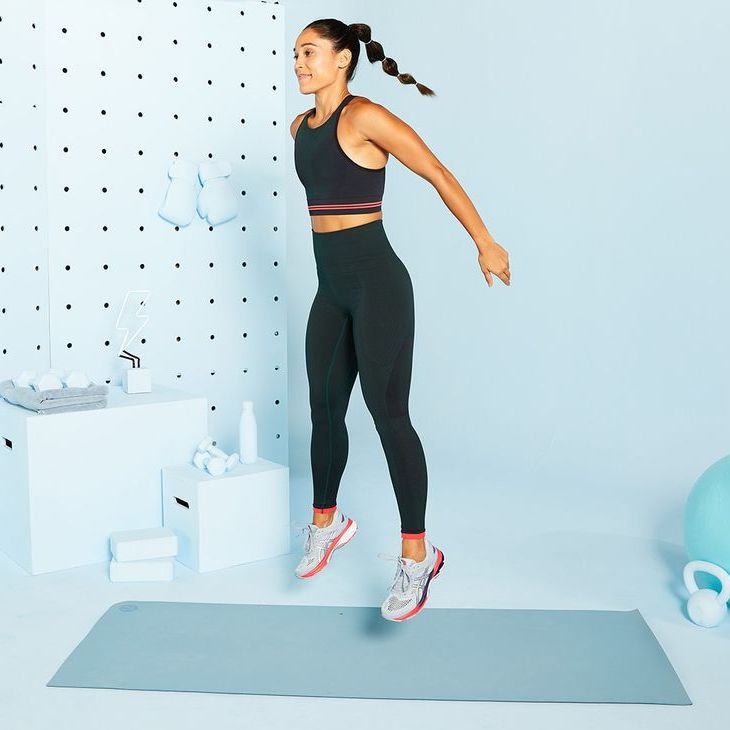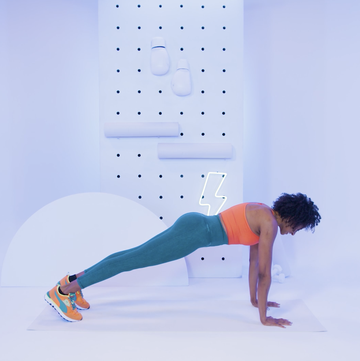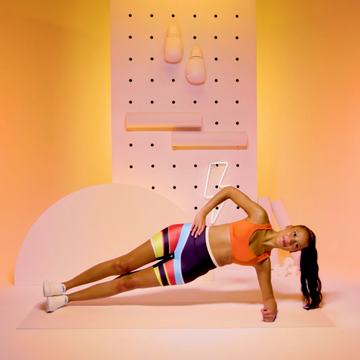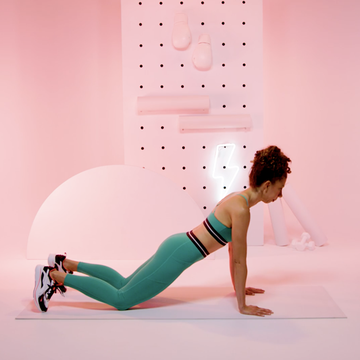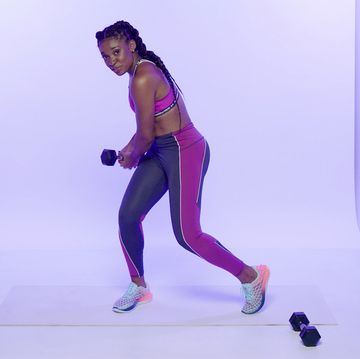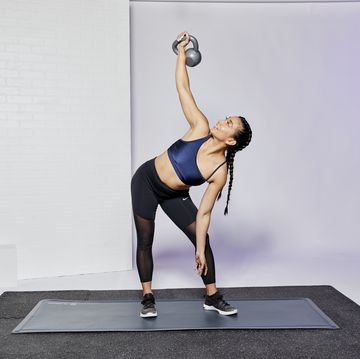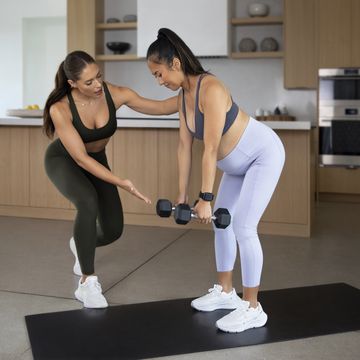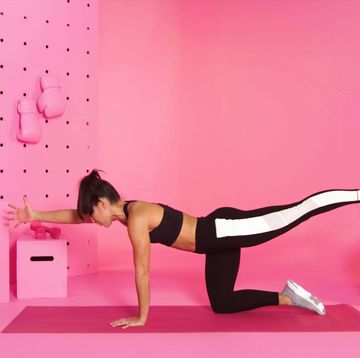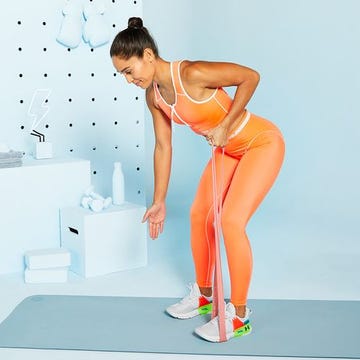Hot girl walks might be the way to move right now, if you have time for a leisurely stroll. If you're looking for a more intense sweat sesh, consider Tabata training. Tabata is an effective way to torch serious calories fast.
“Tabata is a type of high-intensity interval training (HIIT) with specific interval timing and short recovery periods,” explains Chiheb Soumer, CPT, retired Muay Thai fighter and founder of Fairfax Training Club. The quick, 20-minute high intensity workout is named after Japanese speed skating coach Dr. Izumi Tabata, who developed the routine to increase cardiovascular fitness and build muscle strength.
Meet the expert: Chiheb Soumer, CPT, is a retired professional Muay Thai fighter and founder of Los Angeles-based Fairfax Training Club. He has developed programs for UFC Fighters, Navy Seals, Victoria’s Secret models and more.
In a Tabata workout, each round lasts four minutes. It requires 20 seconds of all out effort, followed by 10 seconds of rest, repeated eight times. And when I say "all out,” I mean ALL OUT. We're talking about 100-percent max effort for every burpee, tuck jump, and mountain climber. It's worth pushing yourself though, because that's how you get such a stellar workout in such a short amount of time. (More on the many benefits of Tabata below.)
Here’s the catch: Tabata-style workouts aren’t ideal for newbies. You need to get your form dialed in before you can push yourself safely. Tabata is a great workout to try if you’re strapped for time and looking to rev up your fitness routine with something new.
Sound like you? Get ready to push yourself and fire up your muscles.
20-Minute Full-Body Tabata Workout
Time: 20 minutes | Equipment: Resistance band | Good for: Total body
Instructions: Choose five moves below. Do each move for 20 seconds at maximum effort, resting for 10 seconds in between. Repeat for a total of eight rounds. Once you've completed all rounds of one Tabata exercise, rest for one minute, then continue to the next move.
1. High Knees
How to:
- Start standing.
- Run in place, driving knees towards chest.
- Use arms and try and go as fast as you can (note: the trainer demo-ing this exercise is moving slowly to highlight proper form). Complete as many reps as possible in 20 seconds at maximum effort, followed by 10 seconds of rest. Repeat eight times. Rest for one minute then continue on to the next move.
2. Sprawl
How to:
- Start in a plank position.
- Jump feet toward hands, dropping butt below knees and lifting torso up and raising hands to chest level.
- Jump feet back to plank position. That's one rep. Complete as many reps as possible in 20 seconds at maximum effort, followed by 10 seconds of rest. Repeat eight times. Rest for one minute then continue on to the next move.
3. Skaters
How to:
- Start standing with feet hip-distance apart.
- Jump to the right, landing on right foot and bringing your left leg behind body.
- Jump back to the left, landing on left foot and bringing right foot behind body. That's one rep. Complete as many reps as possible in 20 seconds at maximum effort, followed by 10 seconds of rest. Repeat eight times. Rest for one minute then continue on to the next move.
4. Knee Tuck To Pushup
How to:
- Start in a high plank position.
- Jump knees between hands (or place sliders under feet, and pull knees forward in line with hands).
- Return feet to plank position.
- Bend elbows and lower into a pushup with control. That's one rep. Complete as many reps as possible in 20 seconds at maximum effort, followed by 10 seconds of rest. Repeat eight times. Rest for one minute then continue on to the next move.
5. Tuck Jumps
How to:
- Start standing.
- Jump straight up, tucking knees to your chest.
- Land softly, and immediately repeat that move. That's one rep. Complete 20 seconds at maximum effort, followed by 10 seconds of rest. Repeat eight times. Rest for one minute.
6. Mountain Climbers
How to:
- Start in a plank position.
- Drive your knees toward chest, one at a time, as quick as you can. That's one rep. Complete as many reps as possible in 20 seconds at maximum effort, followed by 10 seconds of rest. Repeat eight times. Rest for one minute then continue on to the next move.
7. Squat Jump
How to:
- Start standing with feet shoulder width apart, toes pointed forward, and weight in heels.
- Lower down into a squat, and then drive through heels to reverse movement and jump up as high as possible.
- Land softly back into the squat position. That's one rep. Complete as many reps as possible in 20 seconds at maximum effort, followed by 10 seconds of rest. Repeat eight times. Rest for one minute then continue on to the next move.
8. Burpees
How to:
- Start standing.
- Squat down to plant palms on mat.
- Immediately, jump feet back into a plank position.
- Perform a pushup.
- Jump feet toward hands.
- Push down through heels to rise up and jump into the air, bringing hands over head.
- Land softly back on mat. That's one rep. Complete as many reps as possible in 20 seconds at maximum effort, followed by 10 seconds of rest. Repeat eight times. Rest for one minute then continue on to the next move.
What’s the difference between Tabata and HIIT?
Tabata is a type of HIIT workout with intervals of 20 seconds on and 10 seconds off. “Tabata is more specific in its interval timing and has shorter recovery periods," says Soumer. "Generally, you do Tabata at a higher intensity than a traditional HIIT workout.
For those of you unfamiliar, HIIT stands for high intensity interval training. “HIIT refers to any type of interval training involving a period of work, followed by a period of rest,” says Soumer. “The work period can be a set time or number of repetitions. During the active phase, exerts yourself as hard as possible to the point of exhaustion.”
Want more? Try this advanced HIIT workout:
Benefits Of Tabata Workouts
All that hard work taking on a grueling Tabata workout is so worth it. Here are the big perks you get from Tabata:
- Boost cardiovascular endurance and aerobic fitness. The method has been proven to increase both aerobic and anaerobic endurance in a study, published in the Journal of Physiological Sciences.
- Save time. The minimal rest periods between high intensity intervals, means you're working efficiently.
- Weight loss. Tabata helps increase lean muscle mass and speeds up your metabolism.
- Reduce boredom. Depending on your specific fitness goals, you can tailor your Tabata exercises to suit your needs. Almost any move can be included in a Tabata workout. “From squats to pushups or lunges, the focus is more in the intensity created,” says Soumer.
Tabata workouts come with some risks.
Before you dive head first into Tabata, you should review the risks of the high intensity style of sweat. (And, check with your doc to make sure it's safe for you.) “Due to the intensity, I recommend it for more advanced individuals," Soumer says. It's also not recommended for anyone with high blood pressure or heart conditions.
Going all out with minimal rest in between intervals means Tabata comes with a higher risk of injury. If you're speeding through reps of an unfamiliar movement and not using proper form, you can hurt yourself. The same is true if you're feeling so zonked and unable to recover between sets.
Starting with a warmup and including a post-workout stretch afterwards helps keep you safe. You can also add in a bit more rest between rounds in order to perform at 100%. "This also reduces the chance of injury from overuse or exhaustion," says Soumer.
